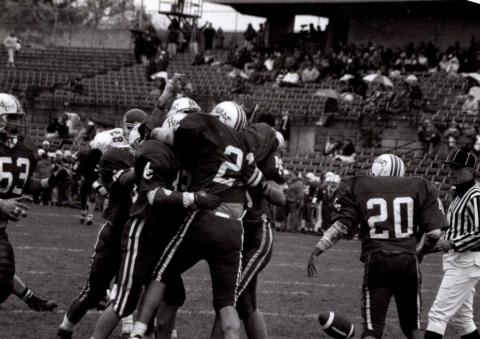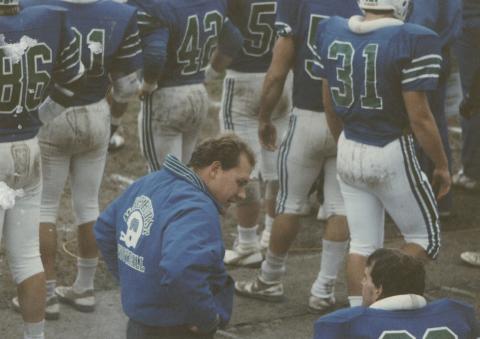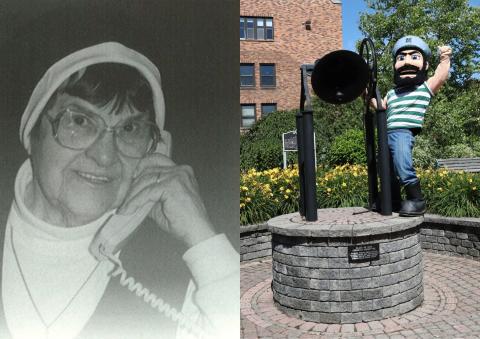History of Athletics
From cheering on the Laker football team at Tullio Field to filling the Mercyhurst Ice Center on winter weekends to watch men’s and women’s hockey in action, much of Mercyhurst’s vibrant student life celebrates the skill and hard work of the Laker athletic teams. But Mercyhurst’s athletic program has humble beginnings. Within a few years after its founding as an all-women's college, Mercyhurst’s foremost athletic offerings consisted of a field hockey team and women’s basketball. The main sports organization on campus was the Athletic Association, which provided opportunities for students to participate in a range of sports throughout the year. Participants faced off against other Mercyhurst classes or, on occasion, against other colleges. The Athletic Association also organized tennis matches and field days.
Another component of the athletics program in these years was the physical fitness program, which provided even more diverse offerings than the Athletic Association. Students took part in typical activities like basketball, swimming, badminton, and hockey, as well as more surprising ones like fencing and archery— not to mention square dancing, an American gym class staple. Between student-organized sports activities and the physical fitness program, Mercyhurst’s athletic offerings were quite suitable to the needs of the student body and contemporary social trends in the school’s early decades.
But times were changing. The 1969 transition to coeducation opened Mercyhurst’s doors to male students – and ushered in a new era for Mercyhurst athletics. With the student population growing in size and diversity, demand increased for sports programs for men and women alike. In the decade that followed, Mercyhurst added over a dozen new teams in eight sports: golf, tennis, rowing, soccer, softball, baseball, volleyball, and basketball. Of these, tennis was first – the establishment of a varsity tennis program was facilitated by the fact that a tennis court had been constructed just a year prior. Student-athletes embraced these new opportunities, wasting no time in achieving victories that showed the nascency of Mercyhurst’s new athletic programs was no disadvantage. Just a year after the creation of a men’s crew team, for example, the team brought home a victory over the renowned Notre Dame University’s crew team. In 1972, the women’s sports teams joined the Association for Intercollegiate Athletics for Women, giving the programs more prestige and deeper connections with other institutions.

The establishment of a football team in 1981 had both tangible and symbolic impact, as it marked the success of Mercyhurst’s transition to coeducation, as well as its ability to compete with other institutions—on the field and in the classroom. Men’s sports teams joined the National College Athletic Association in 1981, followed by women’s teams four years later. In addition to the new football program, the 1980s saw the addition of men’s and women’s cross country and swimming, as well as men’s ice hockey.
To accommodate the rapid growth of Laker athletics, the face of the campus had to change. First came a basketball court housed in the new Campus Center, built in 1977, followed by a new baseball diamond located at the back of campus. In December 1991, the Mercyhurst Ice Center was dedicated. Costing $1.4 million, the Ice Center fixed a problem that had plagued the hockey program since its inception. Previously, hockey players had to travel to all games due to the absence of a venue for home games. This earned them the moniker “The Boys on the Bus” and threatened to impact the players’ academics. With the opening of the Ice Center, hockey players could spend less time on travel and more time on the rink and in the classroom.

The football program gained its own home-field advantage in 1996 with the opening of Tullio Field. Previously, Laker football games had taken place at the Erie Veterans Stadium. Named for the Erie mayor Lou Tullio, whose support made the success of Mercyhurst athletics possible, Tullio Field soon was equipped with AstroTurf, making it one of the only AstroTurf football fields in the region.
With new facilities and a new mascot—the Old Man of the Sea, selected in 1994—Mercyhurst's sports teams were on their way to greatness. By the time Mercyhurst celebrated its 75th anniversary in 2001, it had developed a thriving athletic program that equipped student-athletes with the facilities, coaching, and opportunities they needed to excel on the field and in the classroom. Now that Mercyhurst had the breadth of sports offerings that students sought, including women’s ice hockey and men’s and women’s lacrosse, focus could shift from the rapid addition of more sports teams to the continual enhancement of existing programs. In the past two decades, Mercyhurst's teams have secured national championship victories and consistent advancement to playoff games. Athletic teams recruit both across the United States and internationally to attract new Lakers.

Of course, the success of Laker athletics is magnified by the positive engagement that the athletics program creates on campus. Notable superfans like Sister Damien Mlechick and Joe Hepfinger brought boundless enthusiasm that proved contagious – and lasting. Regardless of the sport, ‘game day’ provides the chance for students to come together in support of their fellow Lakers, making it a memorable experience for players and onlookers alike. Further contributing to student spirit is the Laker Pride marching band, established in 2016, which performs frequently at athletic events and other occasions. Having grown from humble beginnings as a 15-member pep band that began in 2016, Laker Pride now has a membership in the dozens, all of whom are Mercyhurst students who provide their time and talents to inspire and entertain the Laker community.
The face of Mercyhurst athletics has changed greatly over the years. The Old Man of the Sea is no longer, replaced by Louie the Laker—who then became Luke the Laker. With approximately two dozen sports teams and hundreds of student-athletes, Mercyhurst’s athletic program has grown from humble beginnings to become a regional and national powerhouse. Each year brings new triumphs, not only for the players themselves—but for the Laker community as a whole.